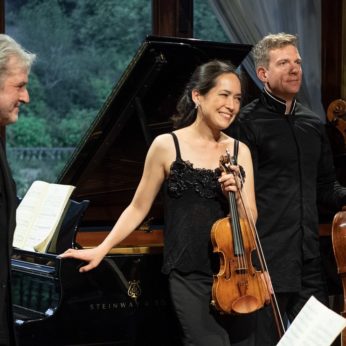Composer: Ludwig van Beethoven (b. 1770 - d. 1827)
Performance date: 03/07/2019
Venue: Bantry Library
Composition Year: 1811
Duration: 00:38:38
Recording Engineer: Ciaran Cullen, RTÉ
Instrumentation: vn, vc, pf
Instrumentation Category:Trio
Artists:
Viviane Hagner -
[violin]
Johannes Moser -
[cello]
Barry Douglas -
[piano]

Viviane Hagner [violin], Johannes Moser [cello], Barry Douglas [piano]
Ludwig van Beethoven [1770-1827]
Piano Trio No.6 in B flat Op.97 – Archduke [1811]
Archduke Rudolph of Austria (1788-1832) was a pupil, a friend and a generous patron of Beethoven. Their association began around 1804 and lasted until the composer’s death in 1827. During the 1809 occupation of Vienna by the French, Beethoven was too distracted to compose seriously, so he diligently prepared composition teaching material for the Archduke, who was his only composition student. The first movement of Das Lebewohl Sonata was presented to the Archduke, dedicated and written from the heart to His Imperial Highness, when he fled Vienna ahead of the advancing French. Rudolf was the only one of his royal patrons who stuck by the composer to the end, and who sufficiently appreciated his greatness to win his sincere friendship. The list of works that Beethoven dedicated to him is formidable: this work and the Op.81 Piano Sonata, the Fourth and Fifth Piano Concertos, the Op.96 Violin Sonata, Fidelio and the Missa Solemnis.
The Archduke was the youngest brother of the Emperor so it is fitting that the work that bears his name should be such majestic and bountiful music. It is written in Beethoven’s Olympian manner with a nobility of expression that transports you to that instantly recognisable world of his greatest works. The opening bars tell you this immediately as the piano sets off with that broad undulating melody. The two strings then interrupt the flow for a moment before all three resume the majestic procession together. Reminders of the theme persist through the transition to the second subject, where we find ourselves unexpectedly in G major. This has various elements, the most important being the slightly hesitant, staccato motif based on the descending scale with which it begins. After the repeat, the massive development section begins as a continuation of the end of the exposition, a pattern of octave triplet figures on all three instruments, but before long the main theme is recalled, while the triplets persist in the piano’s right hand imparting a dream-like quality to these bars. The strings then have a fascinating dialogue, with the piano’s right hand using just three notes of the theme, before the full melody is unfolded again in the cello. The last part of the development gives the opening phrase of the theme to the violin and cello in a delicious pizzicato duet with accompanying trills on the piano. This is then transformed into a succession of scale passages leading back into the recapitulation. The coda looks at the theme one last time.
The main theme of the Scherzo is a jaunty tune played first by the cello and violin alone. The piano creates an equally cheerful subsidiary theme to dance along beside it. The Trio begins with a mysterious chromatic passage led by the cello, which is then treated as a strange fugato in B flat minor. This is then opposed by a dashing waltz-like tune, which keeps interrupting in the rudest way. The whole movement has a manic and surreal feel to it, as though each of the various themes had managed to escape their composer and had taken on a life of their own.
The D major Andante really needs no description. As with some of the late piano sonatas and the late E flat quartet he uses the variation form for some of his most sublime meditations. The theme is presented in the traditional two eight-bar sections, each section heard twice with different instrumentation. The fourth variation poco più adagio sees time disintegrate and we are allowed to glimpse eternity. The coda takes you back there again. Such beauty is actually unbearable.
The Finale is reached without a break, rudely breaking in on our meditations in that typically boisterous Beethoven manner. The theme is deliberately playful reminding us that laughter is the essential antidote to high seriousness. The movement begins as a Rondo but Beethoven’s need to complicate takes us a long way from such careless simplicities. The beginning is straightforward enough, but he then starts mixing styles in the wildest manner concluding with a Presto coda of enormous and disconcerting length, leaving us so battered that the wonders of the slow movement are entirely erased.
Francis Humphrys
Copyright © 2024 West Cork Music. All rights reserved.
Designed and developed by Matrix Internet